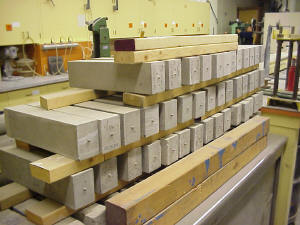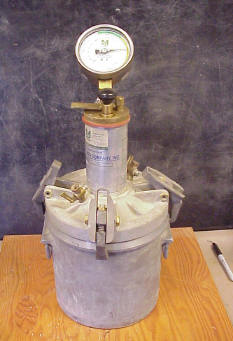Durability is a measure of how PCC performs over time. Durability is one factor in PCC pavement performance. Typically, the two major factors that affect PCC pavement durability are freeze-thaw cycles and chemical attack. Fortunately, steps can be taken to mitigate these factors and tests are available to determine PCC vulnerability to them.
Freeze-Thaw
Freeze-thaw resistance is important in order to avoid excessive cracking, scaling and crumbling. As water freezes it increases in volume by about 9 percent. Thus, as the water in PCC freezes and expands it exerts osmotic and hydraulic pressures on capillaries and pores within the cement paste. If these pressures exceed the tensile strength of the cement paste, the paste will dilate and rupture (PCA, 1988[1]). As this process repeats itself over a number of freeze-thaw cycles, the result can be cracking, scaling and crumbling of the PCC mass.
In the late 1930s it was discovered that purposefully increasing PCC air content (called “air entrainment”) mitigates the effects of freeze-thaw damage. This occurs because the greater air content provides extra void space within the PCC into which the freezing water can expand. Thus, hydraulic and osmotic pressures on the cement paste are minimized, which effectively prevents dilation and rupture. The total air content of the mortar (cement paste + fine aggregate) required to give optimum freeze-thaw protection is about 9 percent, which results in an air content by volume of PCC of between 4 and 8 percent (Mindess and Young, 1981[2]). In addition to the total volume, the distribution of air within the cement paste is also important for freeze-thaw resistance. A properly air-entrained PCC contains a uniform dispersion of tiny bubbles throughout the cement paste. As these bubbles get larger and farther apart, it becomes more difficult for the freezing water to migrate through the cement paste into them. In general, the smaller the bubbles and more uniform their distribution, the better. Actions such as excessive vibration or pumping can adversely affect both total air volume and air distribution. Today, most PCC for exterior use (this includes pavements) is entrained with air to mitigate freeze-thaw effects.
Freeze-Thaw Test

Laboratory testing of PCC freeze-thaw resistance involves subjecting a specimen to a series of rapid freeze-thaw cycles, then reporting a durability factor. First, specimens are created such that they are between 75 – 125 mm (3 – 5 inches) in width and depth or diameter and between 280 – 400 mm (11 – 16 inches) long (see Figure 1). Specimens are then subjected to a number of freeze-thaw cycles in the following manner (AASHTO, 2000[3]):
- The temperature is alternately lowered from 4.4°C (40°F) down to -17.8°C (0°F) and then raised back to 4.4°C (40°F).
- Each of these cycles should take anywhere from 2 to 4 hours.
- The specimen can be thawed in either water or air (the procedures are slightly different).
- Remove the specimen from the freeze-thaw apparatus at intervals not to exceed 36 cycles and determine its dynamic modulus of elasticity and length.
- Cycles are continued until either of the following occur:
- The specimen has been subjected to 300 freeze-thaw cycles.
- The specimen dynamic modulus of elasticity reaches 60 percent of its initial value.
- (Optional) the specimen has experienced a 0.10 percent increase in length.
The durability factor is then calculated as:
![]()
| where: | DF | = | durability factor | |
| P | = | relative dynamic modulus of elasticity at N cycles (in percent) | ||
| N | = | number of cycles at which P reaches the specified minimum value for discontinuing the test (usually 60 percent) or the specified number of cycles at which the test is to be terminated (usually 300 cycles), which ever is less | ||
| M | = | specified number of cycles at which the exposure is to be terminated (usually 300) |
Typically, a DF < 40 indicates a PCC that may have poor freeze-thaw resistance, while a DF > 60 indicates a PCC that has good freeze-thaw resistance (Mindess and Young, 1981). However, there are several limitations to this test. First, it uses 2 – 4 hour freeze-thaw cycles, which are much more rapid than will be experienced in the field. ASTM C 671 solves this issue by using only one freeze-thaw cycle every 2 weeks. Second, even though these cycles are rapid when compared to field conditions, the test can take between 600 and 1200 hours to complete (if the full 300 cycles are tested).
Standard freeze-thaw tests are:
- AASHTO T 161 and ASTM C 666: Resistance of Concrete to Rapid Freezing and Thawing
- AASHTO T 121: Mass Per Cubic Meter (Cubic Foot), Yield, and Air Content (Gravimetric) of Concrete
- ASTM C 671: Critical Dilation of Concrete Specimens Subjected to Freezing
Air Content Tests

Although it is actually the air content within the mortar (cement paste + fine aggregate) that is of concern, cement paste air content is usually what is measured. This air content can be measured in several ways, the most common of which is the pressure method. Using the pressure method, a sample of fresh PCC is placed in a pressure vessel (see Figure 2). The remaining volume of the vessel is filled with water and then the vessel is pressurized. The water level is read once, then the vessel is depressurized and the water level is read again. Finally, using Boyle’s law (The principle that at a constant temperature the volume of a confined ideal gas varies inversely with its pressure) the difference in water levels (which corresponds to a volume) is converted into a volume of air.
Standard air content tests are:
- AASHTO T 152 and ASTM C 231: Air Content of Freshly Mixed Concrete by the Pressure Method
- AASHTO T 196 and ASTM C 173: Air Content of Freshly Mixed Concrete by the Volumetric Method
- AASHTO T 199: Air Content of Freshly Mixed Concrete by the Chace Indicator
- ASTM C 138: Air Content (Gravimetric), Unit Weight and Yield of Concrete
Chemical Attack
PCC can deteriorate over time due to its interaction with various chemicals. Chlorides are of the greatest concern for pavement PCC because they are often contained in deicing compounds. Chloride ions can corrode steel components within PCC such as reinforcing steel or dowel bars. One standard test used for pavement PCC (AASHTO T 259) is described here. In this test, multiple slabs of at least 75 mm (3 inches) thick and 300 mm (12 inches) square are formed then abraded using grinding or sandblasting in order to simulate vehicular wear. Small dams are then built around all but one slab (designated the control slab) and subjected to continuous ponding of a 3 percent sodium chloride (NaCl) solution to a depth of 13 mm (0.5 inches) for 90 days. After 90 days the NaCl solution is removed and the slabs are wire brushed to remove any salt buildup. Slab samples are then taken and measured for chloride ion content at two depths:
- 1.6 mm (0.0625 inches) – 13 mm (0.5 inches)
- 13 mm (0.5 inches) to 25 mm (1.0 inches)
These chloride ion concentrations are compared to the average chloride ion concentration of the control slab to determine the amount and extent of chloride ion penetration. Critical chloride ion concentrations for reinforcing steel corrosion are on the order of 0.6 – 1.2 kg Cl–/m3 (1.0 – 2.0 lb Cl–/yd3) of PCC.
Although sulfate attack is a PCC concern, it is generally not an issue in PCC pavement.
Some standard tests for chemical attack are:
- AASHTO T 259: Resistance of Concrete to Chloride Ion Penetration
- AASHTO T 277 and ASTM C 1202: Electrical Indication of Concrete’s Ability to Resist Chloride Ion Penetration
- AASHTO T 303 and ASTM C 227: Accelerated Detection of Potentially Deleterious Expansion of Mortar Bars Due to Alkali-Silica Reaction
- Portland Cement Association (PCA). (1988). Design and Control of Concrete Mixtures. Portland Cement Association. Skokie, IL.↵
- Mindess, S. and Young, J.F. (1981). Concrete. Prentice-Hall, Inc. Englewood Cliffs, NJ.↵
- American Association of State Highway and Transportation Officials (AASHTO). (2000). Standard Specifications for Transportation Materials and Methods of Sampling and Testing, Twentieth Edition. American Association of State Highway and Transportation Officials. Washington, D.C.↵
